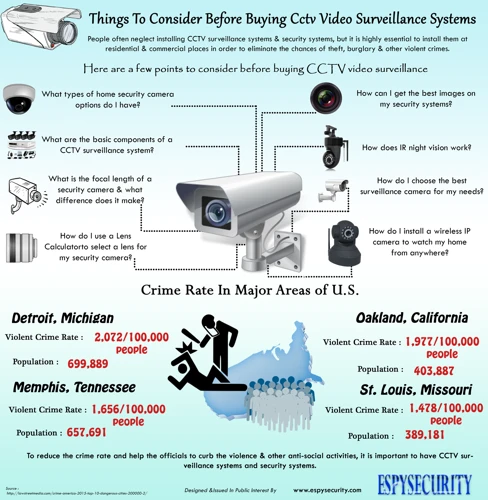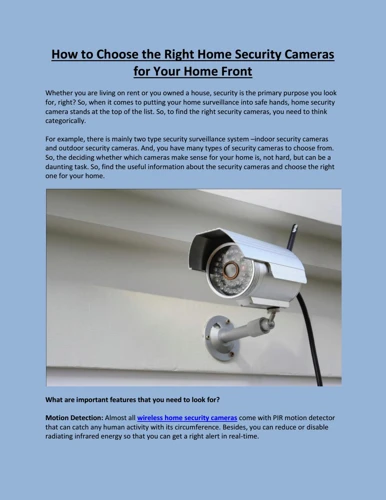Video surveillance cameras have become an essential tool in ensuring safety and security in various environments, including homes, businesses, and public spaces. With advancements in technology, the options for video surveillance cameras have expanded, offering a wide range of features and capabilities. When considering investing in a video surveillance system, it is crucial to understand the key factors that can influence the effectiveness and efficiency of these cameras. In this article, we will explore the essential factors to consider when choosing a video surveillance camera to meet your specific needs.
Resolution

One of the most critical factors to consider when selecting a video surveillance camera is the resolution. The resolution of a camera determines the clarity and quality of the footage it captures. Higher resolution cameras produce sharper and more detailed images, making it easier to identify objects, individuals, or incidents in the footage. Common resolutions for video surveillance cameras include 720p, 1080p, and 4K. Higher resolution cameras are particularly beneficial for scenarios where detailed image quality is essential, such as facial recognition or license plate identification.
Low-Light Performance
In environments where lighting conditions are not optimal, the low-light performance of a video surveillance camera becomes crucial. Cameras with good low-light performance can capture clear and detailed footage even in dimly lit or nighttime settings. Features such as infrared (IR) illumination or low-light sensors can enhance a camera’s ability to capture high-quality images in challenging lighting conditions. When choosing a video surveillance camera, consider the low-light performance to ensure reliable footage regardless of the time of day.
Field of View
The field of view offered by a video surveillance camera determines the area that the camera can cover and monitor. Cameras with a wider field of view can capture more significant portions of a space, reducing the number of cameras needed to monitor a specific area. However, it is essential to balance the field of view with the level of detail required. Cameras with a narrow field of view may offer more detailed images of specific areas but may require more cameras to cover a larger space effectively. Consider the layout of the area you wish to monitor and choose a camera with an appropriate field of view to meet your surveillance needs.
Video Compression
Video compression plays a significant role in storing and transmitting video footage from surveillance cameras. Efficient video compression algorithms reduce the file size of recorded footage without compromising image quality, allowing for more extended storage of video recordings and smoother transmission over networks. Common video compression formats include H.264 and H.265, with H.265 offering higher compression efficiency and better image quality at lower bitrates. When selecting a video surveillance camera, consider the video compression technology to ensure efficient storage and transmission of video footage.
Connectivity
The connectivity options of a video surveillance camera determine how the camera can be integrated into existing surveillance systems or networks. Cameras may offer wired or wireless connectivity options, each with its advantages and limitations. Wired cameras provide a stable and reliable connection but may require professional installation for cable routing. Wireless cameras offer more flexibility in camera placement but may be susceptible to interference or signal loss. Additionally, consider whether the camera is compatible with network protocols such as Wi-Fi or Ethernet for seamless integration into your surveillance setup.
Remote Monitoring
Remote monitoring capabilities allow users to access live video feeds or recorded footage from surveillance cameras from anywhere with an internet connection. Cameras equipped with remote monitoring features enable users to monitor their properties in real-time, check for alerts or notifications, and review footage remotely. Mobile apps or web interfaces provided by camera manufacturers facilitate remote monitoring, providing convenience and peace of mind to users who need to keep an eye on their properties while away. When choosing a video surveillance camera, consider the remote monitoring options available to ensure easy access to your camera feeds.
Weather Resistance
For outdoor surveillance applications, weather resistance is a crucial factor to consider when selecting a video surveillance camera. Outdoor cameras are exposed to various weather conditions, including rain, snow, heat, and humidity, which can affect the camera’s performance and longevity. Look for cameras with an IP (Ingress Protection) rating indicating their resistance to dust and water ingress. Cameras with a higher IP rating are better equipped to withstand harsh weather conditions, ensuring reliable operation and extended lifespan in outdoor environments.
Storage Options
The storage options offered by a video surveillance camera determine how video footage is stored and managed. Cameras may support local storage on SD cards, network-attached storage (NAS) devices, or cloud storage services. Local storage provides a secure and private storage solution but may have limitations on storage capacity. Cloud storage offers convenient access to footage from anywhere and scalable storage options but may incur subscription fees and depend on internet connectivity. Consider your storage needs and preferences when choosing a video surveillance camera to ensure efficient management and accessibility of video recordings.
Audio Capabilities
Some video surveillance cameras come equipped with audio capabilities, allowing users to capture audio along with video footage. Audio can provide additional context to video recordings, enabling users to hear conversations, sounds, or alerts in the monitored area. Cameras with built-in microphones or audio input/output ports can support two-way audio communication, enabling users to interact with individuals in the monitored space. Consider the audio capabilities of a video surveillance camera if capturing audio is essential for your surveillance needs, such as in areas where audio monitoring is required.
Integration with Other Systems
Integration with other security systems or devices can enhance the functionality and effectiveness of a video surveillance camera. Cameras that support integration with access control systems, alarms, or smart home devices can provide a comprehensive security solution for users. Integration allows for automated actions based on camera footage, such as triggering alarms, locking doors, or sending notifications to mobile devices. When selecting a video surveillance camera, consider its compatibility with other systems or devices you already use or plan to incorporate into your security setup for seamless integration and enhanced security capabilities.
Cost
Cost is a significant factor to consider when choosing a video surveillance camera, as prices can vary widely depending on the camera’s features, capabilities, and brand. Set a budget for your surveillance system and prioritize features based on your specific needs and requirements. While it may be tempting to opt for the most expensive camera with all the latest features, consider whether those features are necessary for your application. Compare prices from different manufacturers, read reviews, and weigh the cost against the camera’s performance and features to make an informed decision that fits your budget and security needs.
When setting up your video surveillance system, there are many factors to consider. From calculating video surveillance coverage to understanding coverage areas, camera cables, and resolution options, each aspect plays a crucial role. Explore our articles on calculating video surveillance coverage, coverage areas for video surveillance, video surveillance camera cables, resolution options for video surveillance, and video surveillance resolution for valuable insights to help you make informed decisions.
Conclusion

Selecting the right video surveillance camera involves considering multiple factors to ensure the camera meets your security requirements and budget. Factors such as resolution, low-light performance, field of view, video compression, connectivity, remote monitoring, weather resistance, storage options, audio capabilities, integration with other systems, and cost play a crucial role in choosing the best camera for your surveillance needs. By understanding these factors and their implications, you can make an informed decision when investing in a video surveillance camera to protect your property, assets, and loved ones. Evaluate your priorities, conduct research, and consult with security professionals to find the ideal video surveillance camera that meets your specific requirements and provides reliable security and peace of mind.







